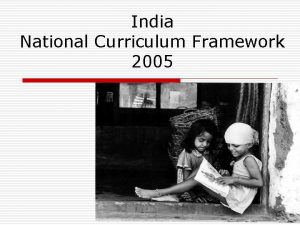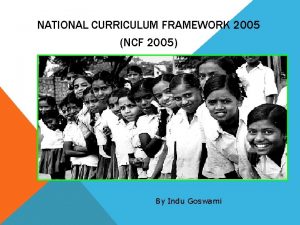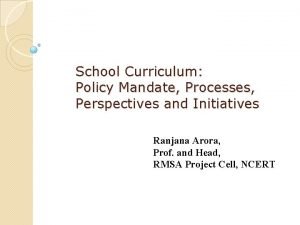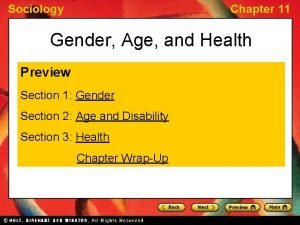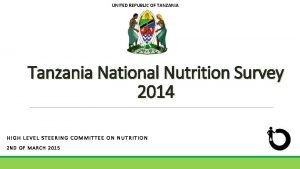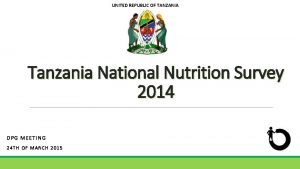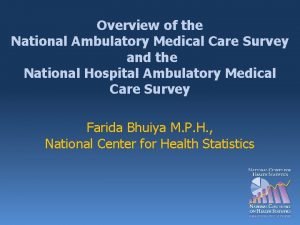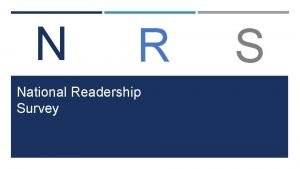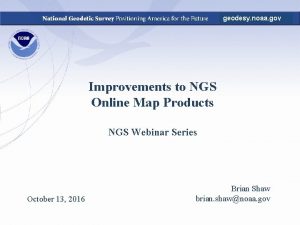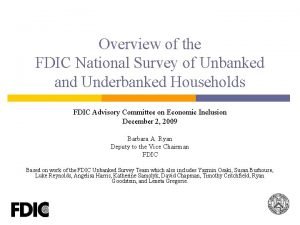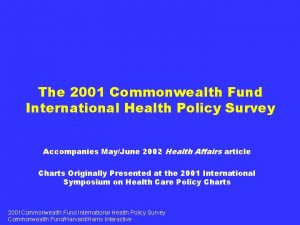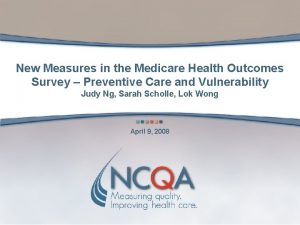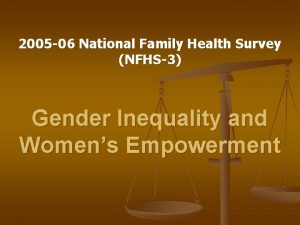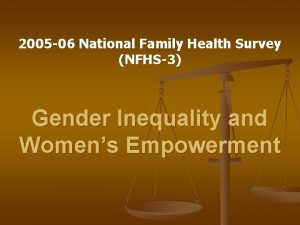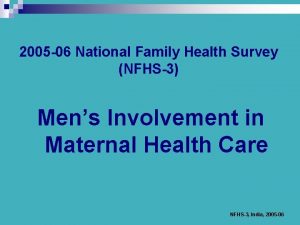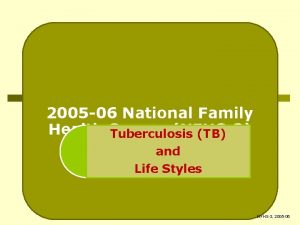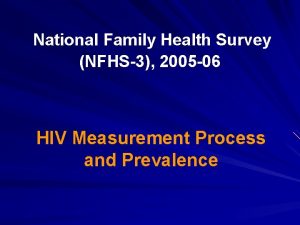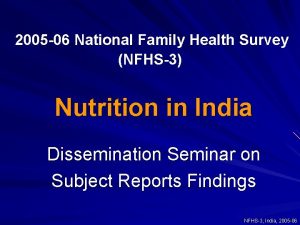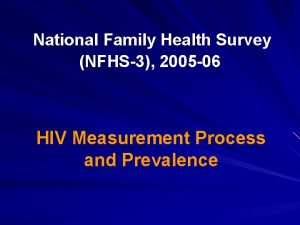2005 06 National Family Health Survey NFHS3 Gender






















- Slides: 22

2005 -06 National Family Health Survey (NFHS-3) Gender Inequality and Women’s Empowerment

Why Measure Gender Inequality and Women’s Empowerment in NFHS-3? n Important public health consequences for women and children n Strategic theme of NPP 2000 Theme: Empowering women for improved health and nutrition n Millennium Development Goals 3 & 4 MDG 3: Promote gender equality and empower women MDG 4: Eliminate gender disparity in education NFHS-3, India, 2005 -06

Content of Presentation n Selected indicators of gender disparity n Access and control over resources n Women’s decision making role n Freedom of movement n Acceptance of gender unequal norms NFHS-3, India, 2005 -06

Gender Disparity in Literacy e Ag Sex Literacy rate (%) Gender Disparity 15 -49 Male Female 78 55 29% 20 -24 Male Female 84 64 23% 15 -19 Male Female 89 74 17% NFHS-3, India, 2005 -06

Gender Disparity in Media Exposure Not only are fewer women than men literate but fewer are also regularly exposed to media n Percentage of men and women age 15 -19 regularly exposed to print media, TV, radio, or cinema n Men 88% n Women 71% n Gender Disparity 19% NFHS-3, India, 2005 -06

Employment: Another Area of Gender Disparity Percent Among the population age 15 -49 n Men are 2 times as likely to be employed n Men are 2. 7 times as likely to be employed for cash n n Among the employed, 64% of women vs. 91% of men earn cash Female share of population employed for cash in nonagricultural occupations is 22% NFHS-3, India, 2005 -06

The majority of employed women are engaged in agricultural work Occupational Distribution (%) Type of worker Women Men Professional 7 7 Sales 4 14 Service 7 5 Production 22 37 Agricultural 59 33 2 4 Other NFHS-3, India, 2005 -06

Does employment empower women financially? n n n NFHS-3 asked married employed women and men who controlled their own earnings and who controlled the spouse’s earnings (if relevant) 20% of employed married women said they earned at least as much as their husband 24% of men with an employed wife said that their wife earned at least as much as them NFHS-3, India, 2005 -06

Control over Women’s Earnings as Reported by Currently Married Women and Men Percent Women’s report about their own earnings Men’s report about their wife’s earnings Mainly husband Husband & wife jointly Mainly wife NFHS-3, India, 2005 -06

Are some women more likely than others to NOT participate in the use of their earnings? Percent of currently married women Age Residence Education Wealth Index NFHS-3, India, 2005 -06

Do married women have access to any other financial resources? Percentage of women who: NFHS-3, India, 2005 -06

Education, employment, or wealth do not ensure that women have money that they control Percentage of women age 15 -49 who have money which they can decide how to use NFHS-3, India, 2005 -06

Do married women participate in other household decision making? Decisions Make decision alone or jointly with husband Own health care 62 Making major household purchases Making purchases for daily household needs 53 Visits to her family or relatives 61 All four 37 None of above 21 60 NFHS-3, India, 2005 -06

• Older women are much more likely than younger women to participate in household decisions • Differentials by other characteristics are small • However, less than half of even the oldest, urban, more educated, employed or wealthier women participate in all four decisions NFHS-3, India, 2005 -06

What are some of the other hurdles that prevent women from attaining gender equality? n n Limited freedom of movement Gender norms that promote men’s control over women. NFHS-3 asked women and men questions about norms regarding Wife beating n A husband’s right to have sex with his wife irrespective of his wife’s wishes n NFHS-3, India, 2005 -06

Percentage of women age 15 -49 who are allowed to go alone to: The majority of women have little freedom of movement. Only one-third go alone to all three destinations: the market, health facility and outside the village or community. NFHS-3, India, 2005 -06

Percentage who agree that a husband is justified in hitting or beating his wife if she: NFHS-3, India, 2005 -06

Percentage who agree with at least one reason for wife beating Women Men Age 15 -19 53 57 Urban 44 43 12+ years education 31 34 Employed for cash 59 62 Wealthiest 37 35 Delhi: A highly urbanized state 32 28 Although urban, educated, employed and wealthier persons are less likely to agree with wife beating, these characteristics are not sufficient to supplant beliefs in gender inegalitarian norms NFHS-3, India, 2005 -06

Attitude towards refusing sex with husband by Situation, Women and Men Percentage who agree that a wife is justified in refusing to have sex with her husband when she: NFHS-3, India, 2005 -06

Percentage of men age 15 -49 who consider that, when a woman refuses to have sex with him when he wants, he has the right to: n Get angry and reprimand her - 20% n Refuse her financial support - 6% n Use force to have sex - 6% n Have sex with another woman - 4% NFHS-3, India, 2005 -06

Key Findings n Women are disadvantaged absolutely and relative to men in terms of access to education, media exposure, and employment for cash. n The majority of married women do not have the final say on the use of their own earnings or all other household decisions asked about. n Traditional gender norms, particularly those concerning wife beating, remain strongly entrenched. NFHS-3, India, 2005 -06

Thank You NFHS-3, India, 2005 -06
 Strategic gender needs and practical gender needs
Strategic gender needs and practical gender needs Acls abcd
Acls abcd National curriculum framework 2005
National curriculum framework 2005 National knowledge commission 2005
National knowledge commission 2005 Guiding principles of ncf 2005
Guiding principles of ncf 2005 Features of ncf 2005
Features of ncf 2005 National programme related to child health and welfare
National programme related to child health and welfare Chapter 11 gender age and health review worksheet answers
Chapter 11 gender age and health review worksheet answers Tanzania national nutrition survey 2018
Tanzania national nutrition survey 2018 Tanzania national nutrition survey 2020
Tanzania national nutrition survey 2020 National ambulatory medical care survey
National ambulatory medical care survey Pamco survey
Pamco survey Ngs cors map
Ngs cors map National hospital care survey
National hospital care survey National survey of unbanked and underbanked households
National survey of unbanked and underbanked households National soil survey center
National soil survey center Singapore national nutrition survey
Singapore national nutrition survey Jamaica health and lifestyle survey
Jamaica health and lifestyle survey Ehis eurostat
Ehis eurostat California health information survey
California health information survey Commonwealth fund international health policy survey
Commonwealth fund international health policy survey Medicare health outcomes survey
Medicare health outcomes survey European health literacy survey
European health literacy survey


